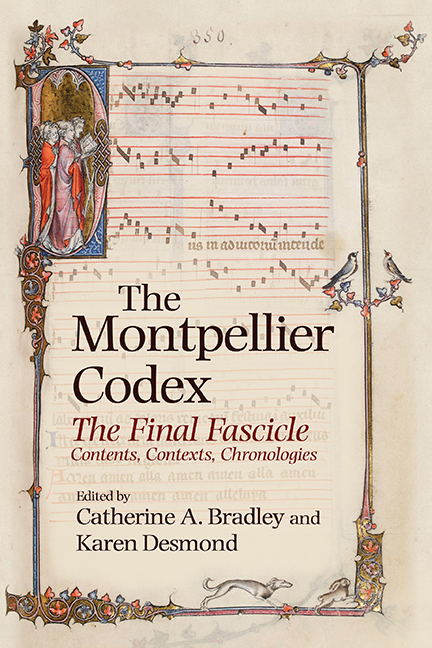Book contents
- Frontmatter
- Contents
- Figures
- Musical examples
- Tables
- Acknowledgements
- List of manuscript sigla
- Abbreviations
- Table of fascicle 8 contents
- Introduction
- I The Material Object
- II INNOVATION AND TRADITION
- III ANALYTICAL CASE STUDIES
- 13 Montpellier 8 PORTARE Motets and Tonal Exploration
- 14 Repetitions, Rhythmical Evolution, and Rhetoric in the Montpellier Codex
- 15 Shedding Light on Mo 8,304: Alma virgo virginum/Benedicta es, Maria
- 16 A Performance and Reception History of On parole/A Paris/FRESE NOUVELE
- Bibliography
- Contributors
- General index
- Index of compositions, alphabetical
- Index of compositions in Mo, manuscript order
- Miscellaneous Endmatter
15 - Shedding Light on Mo 8,304: Alma virgo virginum/Benedicta es, Maria
from III - ANALYTICAL CASE STUDIES
Published online by Cambridge University Press: 04 July 2019
- Frontmatter
- Contents
- Figures
- Musical examples
- Tables
- Acknowledgements
- List of manuscript sigla
- Abbreviations
- Table of fascicle 8 contents
- Introduction
- I The Material Object
- II INNOVATION AND TRADITION
- III ANALYTICAL CASE STUDIES
- 13 Montpellier 8 PORTARE Motets and Tonal Exploration
- 14 Repetitions, Rhythmical Evolution, and Rhetoric in the Montpellier Codex
- 15 Shedding Light on Mo 8,304: Alma virgo virginum/Benedicta es, Maria
- 16 A Performance and Reception History of On parole/A Paris/FRESE NOUVELE
- Bibliography
- Contributors
- General index
- Index of compositions, alphabetical
- Index of compositions in Mo, manuscript order
- Miscellaneous Endmatter
Summary
That a tenor line's liturgical context was expected to hold some significance for the subject matter of a motet is attested by the fourteenth-century theorist Egidius de Murino. He writes: ‘First select a tenor from any antiphon or responsory or other melody in the antiphonary, and the words should correspond to the material that you want to treat’ (Primo accipe tenorem alicuius antiphone vel responsorii vel alterius cantus de antiphonario et debent verba concordare cum materia de qua vis facere motetum). A substantial branch of motet scholarship in recent decades has explored the musical and textual interplay between tenors drawn from liturgical chants and the texted voices placed above them. Focusing on Alma virgo virginum/Benedicta es, Maria/[TENOR] (Mo 8,304, fols 350v–351v, hereafter Mo 304), the first motet in fascicle 8 following the opening Deus in adiutorium, this study explores the apparent mismatch between the motet's tenor and its upper voices.
The triplum and motetus texts clearly align the motet with the Feast of the Assumption:
The tenor, however, which has no designation in the manuscript, has associations with the Holy Saturday responsory Plange quasi virgo, aligning the motet with Passiontide suffering, darkness, and death – themes apparently incompatible with the celebratory Assumption texts of the upper voices. This study explores how the interaction of Mo 304's three voices brings out meanings that would not otherwise be obvious – or indeed present at all – in each separate vocal line. The study considers how these meanings, which give subtle thematic unity to the motet, might facilitate the identification of the tenor part and the motet's original performance context.
MO 304'S TENOR AND ITS ASSOCIATION WITH THE HOLY SATURDAY RESPONSORY PLANGE QUASI VIRGO
Mo 304's tenor uses a set of twenty-three pitches repeated three times (see Example 15.1a). Its liturgical source remained unidentified in scholarship until 1969, when Gordon Anderson suggested that it derived from the melisma et amara (‘and bitterness’) in the chant Plange quasi virgo, the third responsory of Matins Nocturn I on Holy Saturday, as given in the Sarum Antiphonal (Example 15.1b). The Plange quasi virgo responsory as given in BnF lat. 15181, fol. 291r, from Paris c.1300, is geographically and temporally pertinent to Mo 304, and gives a slightly closer match with the tenor line (Example 15.1c).
- Type
- Chapter
- Information
- The Montpellier CodexThe Final Fascicle. Contents, Contexts, Chronologies, pp. 269 - 282Publisher: Boydell & BrewerPrint publication year: 2018



